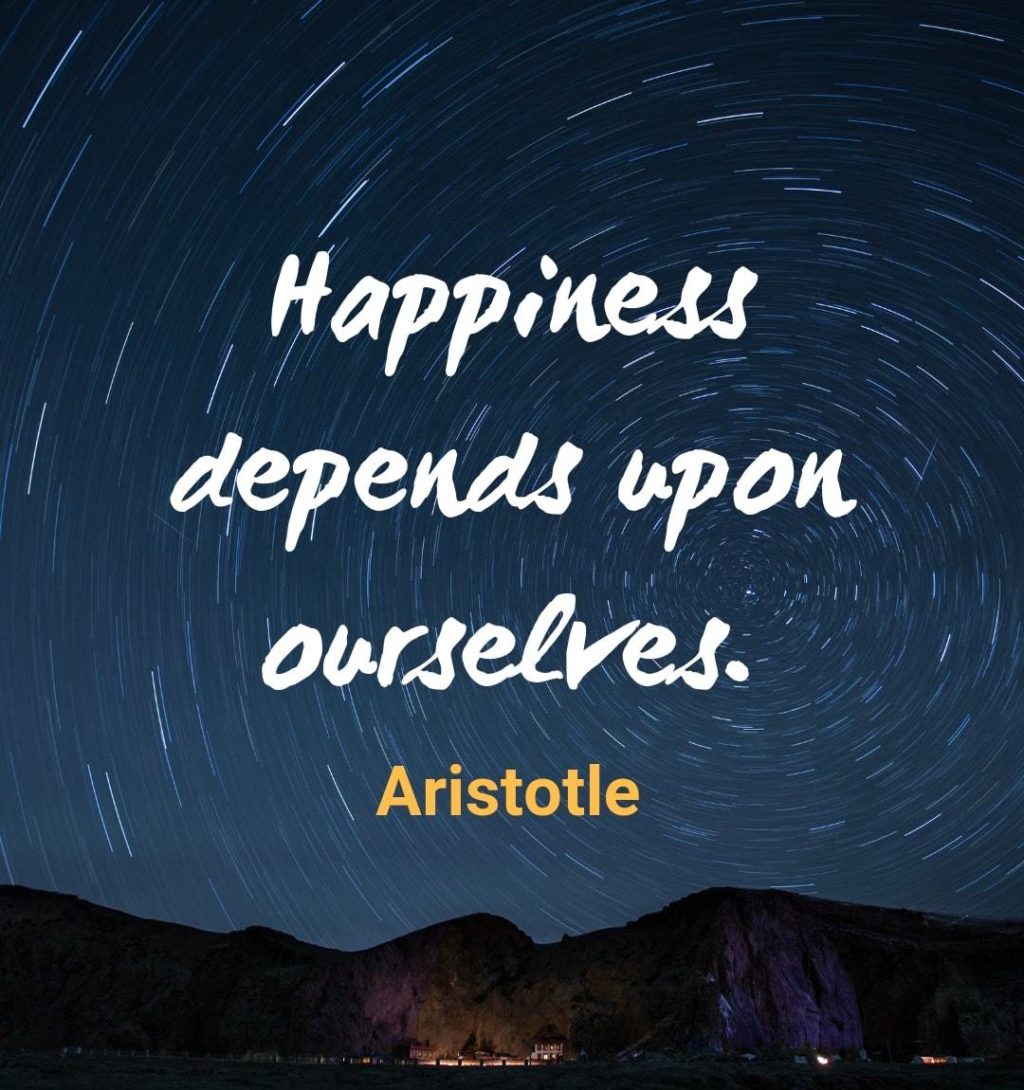There might be affiliate links on this page, which means we get a small commission of anything you buy. As an Amazon Associate we earn from qualifying purchases. Please do your own research before making any online purchase.
Have you ever wondered what lasting happiness looks like? Have you ever wished to achieve authentic well-being?
Each of us -no matter the race, culture, or socio-economic background we were born and raised in – want a happy and joyful life.
The only thing that differs is the means through which we achieve it. While some focus on momentary pleasures, others choose to pursue long-term goals. And this is where the difference between hedonic and eudaimonic happiness is most conspicuous.
But what is eudaimonic happiness, you might ask. For those of you who haven’t heard about eudaimonia, this concept has been around for nearly 2000 years.
Unfortunately, no one – except a handful of philosophers and thinkers – has given it too much attention.
However, in recent years, psychologists have begun to understand the implications of eudaimonic happiness and well-being. It appears this approach to life can lead to substantial growth, inner peace, and prosperity.
What Is Eudaimonia Anyway?
Eudaimonism is a philosophical approach to life, happiness, and well-being. This concept represents the central piece of Aristotelian philosophy and often a ‘hot’ subject of debate for philosophers and thinkers.
From an etymological standpoint, eudaimonia is a Greek word containing “eu” (“good”) and “daimōn” (“spirit”). This words roughly translates to happiness or, as some recent experts argue, flourishing or prosperity.
The history of eudaimonism began 2000 years ago when Aristotle argued that the secret to a better life and a better society is a mix of happiness (eudaimonia) and virtue of character. In fact, he believed these two concepts should be the main pillars of political philosophy.
Eudaimonic happiness and well-being represent the greatest form of human goodness; an ideal which both Aristotelian and Stoic philosophers promote as the foundation of a genuinely beautiful and harmonious life.
In a way, eudaimonic happiness is the opposite of hedonic happiness in the sense that it encourages us to give up momentary pleasures in favor of long-term goals and lasting happiness.

What Is Eudaimonic Happiness and Well-Being?
We know for a fact that each of us places happiness and well-being at the top of our list of priorities. While for some happiness means going on vacations and having tons of fun, others choose to pursue through professional achievements.
But is happiness the only foundation of a good life? In other words, does feeling good all the time and investing in activities that generate satisfaction represent the sign of quality life?
Some experts believe that when it comes to happiness, we have yet to zero in on a specific definition that captures all possible facets of this complex phenomenon. In fact, many of the existing definitions have almost occurred by chance.
When researchers began to take a keen interest in happiness and well-being, the first thing they did was to assess people’s perception of a good life. But the surveys and questionnaires they used didn’t cover the entire spectrum of elements that comprise the notion of human happiness.
And even though they discovered so much about happiness, it almost felt (and still feels) like they knew very little.
Can we experience authentic fulfillment without knowing why we live; without having a clear direction; without a sense of purpose? Is it possible to feel happy without making significant changes and investing in our personal growth?
Well… we can’t. And many current theories on happiness fail to consider crucial concepts like growth, self-fulfillment, and purpose.
This is where eudaimonic happiness comes into play, offering a completely different perspective on what it means to have a good life. By discovering our purpose and investing in personal growth, we can achieve fulfillment and live the life we’ve always wanted to have.
The concept of eudaimonic well-being is comprised of six crucial elements that experts believe are a prerequisite for authentic and lasting happiness:
- Autonomy
- Personal growth
- Environmental mastery
- Positive relations
- Self-acceptance
- Purpose in life
We’ll get into more detail about each of these concepts later.
For now, let’s take a quick look at the current scientific literature on eudaimonic happiness and well-being.
What Do Researchers Have to Say About Eudaimonic Happiness and Well-Being?
Although Aristotelian and Stoic philosophers were the first to promote eudaimonic happiness as the ideal path to authentic fulfillment and well-being, 21st-century psychologists (especially positive psychologists) believe this concept plays a crucial role in both physical and mental health.
In fact, the concept of eudaimonic well-being has gained so much popularity in the scientific community that experts have begun designing tools to measure and quantify this multifaceted process. [1]
Regarding health benefits, the eudaimonic perspective on well-being emphasizes the importance of a purpose-driven existence. In turn, this approach can reduce morbidity, extend longevity, and act as a protective buffer against increased health risk among the educationally disadvantaged. [2]
When it comes to motivation and change, researchers believe eudaimonia, compared to hedonic well-being, is a much safer road to happiness. [3] In other words, the pursuit of momentary pleasures does not cultivate long-term satisfaction and well-being.
Overall, researchers and mental health professionals believe eudaimonia represents the foundation of lasting health and well-being; an approach that entails lasting growth on all levels.
Hedonic vs. Eudaimonic Views of Happiness and Well-Being
When we think about happiness, the first thing that comes to mind is probably a set of activities and experiences that generate pleasure and satisfaction.
We associate happiness with eating our favorite ice cream, going somewhere special, or simply being free of any stress that may interfere with our positive mood.
That’s what experts call ‘hedonic’ happiness or ‘hedonic’ well-being. In other words, the sense of happiness and satisfaction that results from giving course to a momentary pleasure or ‘whim.’
In a way, hedonic happiness is perhaps the easiest and fastest way to experience positive emotions and relieve any frustration that may result from keeping our desires and needs bottled up.
Hedonic happiness or well-being is characterized by the presence of positive emotions; the absence of negative emotions; and life satisfaction.

Sounds like the ideal approach to happiness, doesn’t it!
However, ever since Aristotle, there were some who considered hedonic happiness vulgar. Advocators of Stoicism believe that once we choose to pursue pleasure above all else and avoid discomfort at any cost, we become slaves of desire.
We abandon long-term goals in favor of short-term satisfaction, and we sacrifice self-discipline for the sake of pleasure.
Of course, we shouldn’t look at hedonism in such an absolutistic manner. In fact, there are times when indulging in momentary pleasures or avoiding a ‘bad’ emotion can be extremely beneficial. Moderation is the key here.
But what about lasting happiness? What if we wish to maintain an overall positive mood and transform happiness into a lifelong journey?
Eudaimonic views of happiness and well-being emphasize the role of self-discovery and personal growth as a means through which we achieve a truly satisfying life.
Cultivating eudaimonic happiness means tolerating the frustration that may occasionally arise from setting aside momentary pleasures in favor of long-term goals.
In other words, this approach helps you develop resilience and discipline, two qualities that prove extremely useful during those times when things don’t go according to plan, and you’re ‘forced’ to face all sorts of adversities.
All and all, the eudaimonic approach to happiness and well-being is character-building; a lifestyle that focuses less on pleasure-seeking behaviors and more on virtue and the expression of our inner potential.
The Six ‘Pillars’ of Eudaimonic Happiness
Although eudaimonia was initially a somewhat general and highly debatable philosophic concept, experts in the field of Psychology have managed to identify the ‘building blocks’ of eudaimonic happiness and well-being.
According to Professor Carol Ryff, eudaimonic happiness is made up of six crucial elements:
1. Autonomy
Autonomy is a basic psychological need. It means being an independent person who doesn’t care that much about other people’s opinions and is confident enough to pursue his/her own path in life.
2. Self-acceptance
This refers to accepting yourself wholly – with strengths and weaknesses – and seeking ways to improve yourself on a constant basis.
3. Purpose in life
This refers to discovering something meaningful that goes beyond “the small pleasures of life.” Your purpose in life is something that guides your every action and decision.
4. Personal growth
Personal growth is the need to explore your inner potential and use it to pursue your real purpose in life.
5. Environmental mastery
Learning to navigate your environment effectively by using the internal and external resources you have at your disposal.
6. Positive relations
Investing in meaningful relationships with people who resonate with your needs, desires, and overall views on life.
As you’ve probably figured out by now, most experts place eudaimonic happiness above hedonic happiness. But why exactly is eudaimonia a better approach to happiness and well-being?
Eudaimonia: The Secret to Lasting Happiness and Well-Being
The fact that eudaimonia emphasizes the value of lasting happiness and well-being makes it the ideal approach to life satisfaction.
Unfortunately, many of us have grown so accustomed to indulging in momentary pleasures and satisfying our (often irrational) whims, that it’s difficult to exercise the kind of discipline and self-control that would help us achieve authentic and lasting well-being.
Nowadays, researchers have begun to explore various aspects that, despite being crucial to our overall sense of well-being, have been seriously neglected.
For example, purposeful engagement in life, realization of personal talents and capacities, and enlightened self-knowledge. [4]
Furthermore, experts claim the eudaimonic approach impacts all areas of our life, from personal development, professional growth, and overall health to family relations, social interactions, and community activities.
But before we get to how we can implement the concept of eudaimonic happiness and well-being in our everyday life, let’s make one more stop to explore how eudaimonia impact your work life.

How Does Eudaimonia Impact Your Professional Life?
Since most of us spend a significant portion of our waking hours at the office, it’s essential to explore how eudaimonic happiness and well-being can contribute to a better working environment.
A recent paper concluded that Aristotle and Cicero’s writings might play a vital role in promoting concepts like wisdom and moral duty as valuable theoretical foundations for business management practices. [5]
As for entrepreneurship, experts believe the eudaimonic approach may offer aspiring entrepreneurs a better adherence to long-term goals and a more positive perspective on failure – one of the biggest challenges that entrepreneurs often ‘joggle’ with. [6]
Overall, it seems the eudaimonic views on happiness and well-being can be successfully implemented in both our personal and professional life.
5 Strategies to Cultivate Eudaimonic Happiness
Cultivating eudaimonic happiness and well-being is a lifelong journey. It’s not just something you do for a limited period but something you invest in on a constant basis.
Here are some tips to get you started:
1. Develop a mindful attitude towards yourself (and the world)
The first step towards cultivating eudaimonic happiness is a change in attitude – towards yourself and the world.
I don’t know if you’ve noticed, but people today spend less and less time with themselves. We move from one deadline to another, without ever asking ourselves why we do it. We invest most of our waking hours in other people’s dreams, and we slowly lose sight of who we are and what’s truly important to us.
If you wish to rediscover your dreams, passions, and purpose, you need to start by paying more attention to yourself. You need to put aside the painful past and worrying future, and for once remain anchored in the present moment.
A mindful attitude means being in control of your actions and decisions. It means being present in every activity that you perform and paying attention to the changes that may occur in your environment.
Those who live mindfully don’t allow themselves to be continuously distracted by trivialities; they don’t avoid ‘bad’ feelings, and they strive to understand themselves on a deep level.
Only by choosing to live in the ‘here and now’ you will be able to develop a mindful attitude that allows you to make conscious decisions and avoid being carried away by life’s never-ending tasks and distractions.
2. Accept yourself (your entire self)
It is difficult to overcome obstacles and make positive changes when you’re too ashamed or stubborn to admit you’re not the person you think you are. It’s impossible to achieve lasting happiness when you waste your inner resources trying to hide your flaws and weaknesses.
Acceptance plays a vital role in eudaimonic happiness and well-being. By accepting yourself as a flawed but unique human being, you will cease to pretend you’re someone else and start focusing on who you truly are.
You can’t make positive changes and achieve eudaimonic growth if you don’t accept yourself genuinely and wholly.
Pick up a fresh piece of paper and draw a big circle on it. In that circle, write down all your qualities, and flaws. Think about each and every aspect that defines who you are – your personal, professional, and social life. Leave no stone unturned.
The idea behind this exercise is to put them all in one place – strengths and weaknesses, inner resources and self-imposed limits,
Once you accept yourself (your entire self), you will gain a clear perspective on who you need to become in order to achieve lasting happiness.

3. Live a purpose-driven life
One of the key elements of eudaimonic happiness and well-being is purpose. In other words, people who live purpose-driven life have a better shot at achieving lasting happiness.
Instead of moving from one goal to another, without a clear direction or a bigger plan, they choose to follow a lifelong purpose. They aim high and build their entire life (personal, professional, social) around a single ideal that governs their every action and decision.
But to live a purpose-driven life, first you need to discover what your purpose is. And that’s why the first two steps – developing a mindful attitude and accepting yourself – are so crucial to eudaimonic growth.
In other words, learning to pay more attention to yourself, your inner world, and accepting your flaws, limits, and shortcomings as part of being a perfectly imperfect human being gives course to a bit of soul-searching.
And once you get to know yourself, you can start putting together a lifelong purpose that will guide your steps toward self-fulfillment and joy.
As the saying goes,
Happiness is not a destination; it’s a way of life.
4. Invest in skill mastery
In a way, happiness and well-being are as much about ‘material’ goals as they are about ‘spiritual’ endeavors. More specifically, it’s hard to feel happy, healthy, and content, when you can’t get a decent job to pay your bills, invest in your hobbies, or put something aside for rainy days.
Skill mastery is one of the most practical approaches you can take to achieve eudaimonic happiness. By knowing what you’re good at, investing in the talents you already have, and making an extra effort to acquire new abilities to create a happy life.
And the best part is that skill mastery has become relatively accessible these days. We’re living in an era where information is only one click away. Everything we wish to learn; everything we’ve ever dreamed of being good at is now more achievable than ever.
The Internet is bristling with insightful articles, educational videos, and step-by-step guides that can help you acquire the skills you need to build a happy life.
Education and skill mastery don’t always have to be formal; all you need is the willingness to study and practice enough to sharpen your skills and adopt new ones.
5. Cultivate positive relationships
Human beings are, by nature, social creatures. We share goals, exchange ideas, offer emotional support, and help each other grow. In fact, collaboration has contributed to our society’s development just as much as competition.
We’ve reached a point where it’s almost impossible to survive and thrive on your own. Your physical, emotional, and mental well-being depends, to a certain extent, to how well we interact with other people.
Consequently, the people with whom you spend most of your time can have a significant impact on your happiness.
People who encourage you to express yourself freely; people who can listen and empathize with your struggles; people who offer you support when the going gets tough, these are the kind of people that will motivate you to achieve lasting happiness.
But aside from understanding, encouragement, and emotional support, you also need guidance and constructive criticism.
Although it may feel uncomfortable to hear an opposing view or some ‘tough’ feedback from someone you hold dear, that’s the kind of friend/relative/coworker that will help you build resilience and find original ways to thrive on all levels.
Final Thoughts on Eudaimonic Happiness
In the end, it seems happiness is a complex, multidimensional phenomenon that can still surprise experts who’ve probably studied it for decades.
Although the eudaimonic principles are the path to lasting happiness and well-being, there are times when indulging in momentary pleasures can be beneficial to your overall well-being.
In other words, both hedonic and eudaimonic views on happiness have a part to play in your overall sense of fulfillment.
In fact, some experts claim that the hedonic and eudaimonic notions of happiness are difficult to separate. [5] To put it differently, you can’t have one without the other.
But since hedonic happiness is something we’re all so familiar with, perhaps now’s the time to invest in a more lasting from of happiness.
Eudaimonic happiness and well-being are part of a lifelong journey; a journey that will bring you authentic joy and fulfillment.
For more resources on helping you achieve happiness, check out these blog posts:
- Happiness is a Choice: 7 Reasons to Choose It for Your Life
- Happiness VS Contentment: Which Should You Seek in Life?
- What Makes People Happy: 54 Ideas on How to be Happy
Finally, one proven way to improve your happiness and life satisfaction is to focus on goals that truly matter. To get started, check out this FREE printable worksheet and a step-by-step process that will help you set effective SMART goals.
References
[1] A. S. Waterman, S. J. Schwartz, B. L. Zamboanga and B. M. Donnellan, “The Questionnaire for Eudaimonic Well-Being: Psychometric properties, demographic comparisons, and evidence of validity,” The Journal of Positive Psychology, vol. 5, no. 1, pp. 41–61, 2010.
[2] C. D. Ryff, “Eudaimonic well-being, inequality, and health: Recent findings and future directions,” International review of economics, vol. 64, no. 2, pp. 159-178, 2017.
[3] S. M. Kennon, M. Corcoran and M. Prentice, “Pursuing Eudaimonic Functioning Versus Pursuing Hedonic Well-Being: The First Goal Succeeds in Its Aim, Whereas the Second Does Not,” Journal of Happiness Studies, p. 1–15, 2018.
[4] C. D. Ryff, “Psychological Well-Being Revisited: Advances in the Science and Practice of Eudaimonia,” Psychotherapy and Psychosomatics, vol. 83, pp. 10-28, 2014.
[5] M. W. Small, “Developing wisdom and moral duty in management,” Journal of Management Development, vol. 30, no. 9, pp. 836-846, 2011.
[6] C. D. Ryff, “Entrepreneurship and eudaimonic well-being: Five venues for new science,” Journal of Business Venturing, 2018.
[7] T. B. Kashdan, R. Biswas-Diener and L. A. King, “Reconsidering happiness: the costs of distinguishing between hedonics and eudaimonia,” The Journal of Positive Psychology, vol. 3, no. 4, pp. 219-233, 2008.

Alexander Draghici is a licensed Clinical Psychologist, CBT practitioner, and content writer for various mental health websites. His work focuses mainly on strategies designed to help people manage and prevent two of the most common emotional problems – anxiety and depression.


